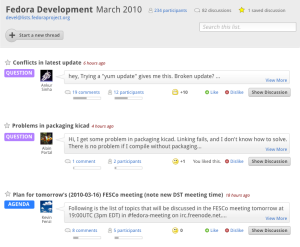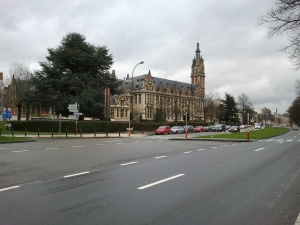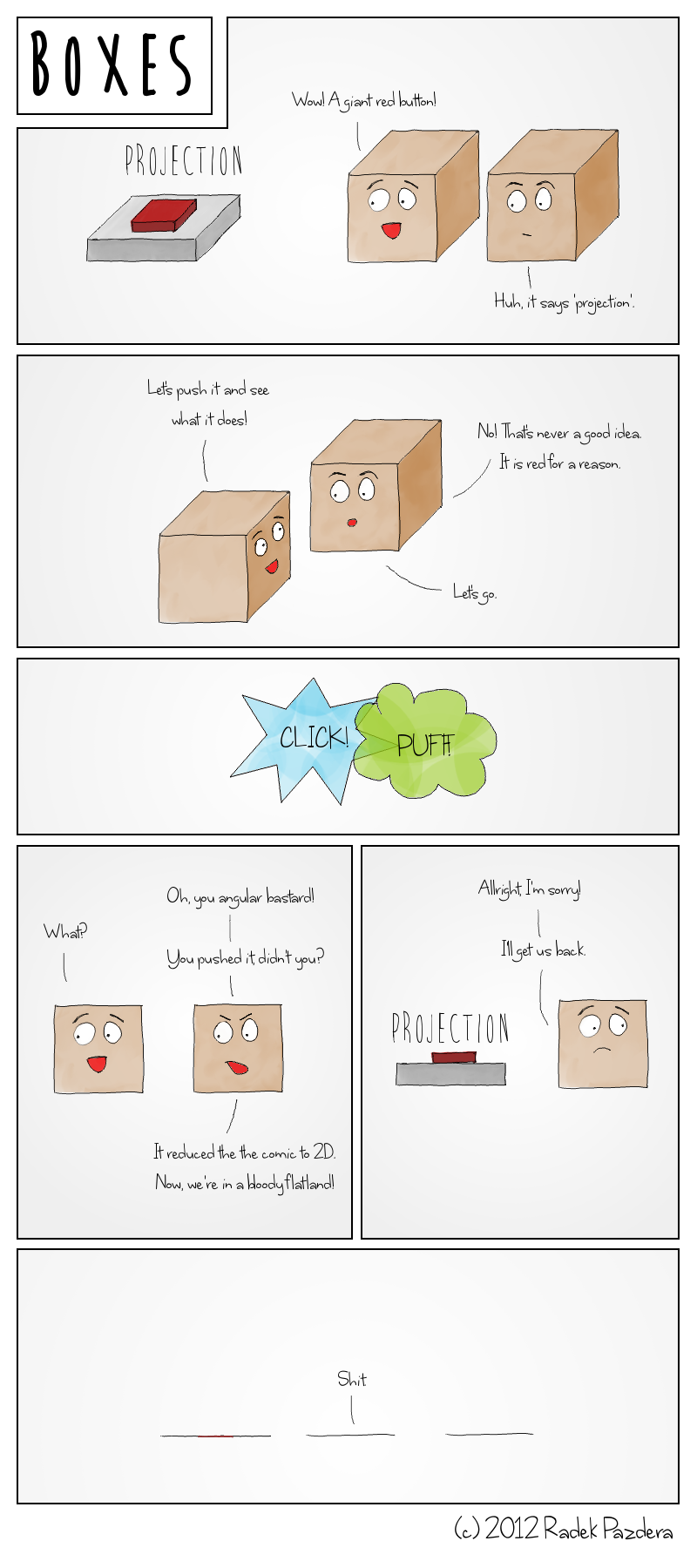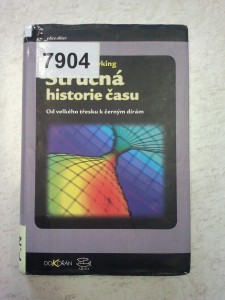Category: General
Developers Conference 2013
The Developers Conference took place in Brno this past weekend (February 23rd, 24th). The #devconf is an annual event organised by the Red Hat office in Brno with the members of the Fedora and JBoss.org communities. The convention targets primarily Linux and JBoss developers and admins and it covers a range of topics from the free software universe.
This year, there were three main tracks, one of which was focused primarily on JBoss and the remaining two on Linux-related topics, such as kernel, networking, security or virtualization/cloud technologies. Apart from that, the conference hosted a number of hackfests and lab sessions for people who wanted to learn something more practical, or have a more focused discussion on a certain topic.
I was there this year and it was amazing. According to the numbers posted to Twitter, the conference had at least 500 attendees on Saturday. There were so many great talks and the organisers had to even turn down presenters, only because there was no room for more. Actually, I don’t think that three tracks will be enough next year.
Saturday
I didn’t get up very early, so for me, Saturday started with a talk from Debarshi Ray about the Gnome Online Accounts. Debarshi talked about how the new Gnome 3.8 integrates with various online services, such as Google Docs/Mail, Facebook, Flickr, ownCloud and others. The integration is a very promising area in my opinion, because these services are used by millions of people. However, there are still some problems that need to be addressed and that are being worked on.
The track in the D3 room continued with Tom Callaway‘s talk on Fedora User Experience. Tom explained the design driven methodology; that we should think about the user experience, before we code. However, the community around Fedora has been focused on the contributors, which are quite often technical people who like to code first. He presented several mockups they have been working on. The first one is a sort-of a rich web interface for mailing lists called Hyperkitty. The goal of this project is to improve the collaboration in communities. At the moment, there are two groups of users, one preferring mailing lists, the second discussion boards. People from these two group tend to miss each other. Hyperkitty should also provide a karma functionality, to help decrease the pollution of big mailing lists from chronically non-constructive people wasting everyone’s time with pointless discussions.

Hyperkitty Design (source: http://blog.linuxgrrl.com/)
The third presentation I saw, again in the D3 room was Negotiation theory for Open Source Hackers by Leslie Hawthorn. This was one of the less technical talks, but it was very insightful. Arguing takes up a fair amount of the time and effort technical people put into their work, especially in open source, and it is not always time well spent. The slides from this presentation are available here.
After Leslie’s talk, we moved to the kernel track in D1 to see Lukáš Czerner speak about what is happening in the local Linux Kernel File Systems. Lukáš summarized the new features from XFS (being the most suitable option for enterprise workloads), ext4 (great for general-purpose), and btrfs (still not stable). Based on the comparison of the number of commits made during the last year, the most active development is going on in btrfs. Its codebase also grows steadily while XFS have lost some weight during the last few years as its developers try to remove unnecessary things. He also discussed the challenges file system developers will need to deal with in the future. The rules of the game don’t change that much with SSD’s, but PCI-based solid-state drives can be problematic, as the current block layer doesn’t scale that well to storage technologies that fast. Similar increase of speed has already happened in networking, so the future development might be inspired by some ideas from that area.
After the file systems update, it was time for my talk about the Linux Network Stack Test project. LNST is a network testing tool designed to simplify testing of real-life scenarios with more than one computer involved. It provides some building blocks for test development and it also serves as a test management tool that will handle proper execution of your test cases. The tests created using LNST are then entirely automated and also completely independent from the underlying network infrastructure, so they can be migrated to a different network without any changes whatsoever. This is important when you want to share them with others.
Slides: You can download the slides I used for the LNST presentation here.
I took a short break from the presentations after that and I returned to see Daniel Borkmann with his presentation about the zero-copy packet capturing and netsniff-ng. At this point, I started to get really tired, so I certainly didn’t catch everything here. And finally, the kernel track was closed by three lighting talks by Jiří Benc on PTP, Jiří Pírko who gave us an update about what happened in the team driver, and Zdeněk Kabeláč who closed the room with his talk about LVM2.
If you came early enough to get a keyring at the entrance to the venue, you were in possession of a ticket to the after party, which took place approximately half an hour later at Fléda. The party was, just as the conference itself, awesome. There was beer and food for free, a live band, and most importantly hundreds of like-minded people and colleagues from Red Hat to talk to about Linux :).
Sunday
Sunday was again crammed with amazing talks. This time, I made sure not to oversleep (even though getting up after the party wasn’t easy at all). The very first talk in the morning in D3 was Evolution of Linux Network Management from Pavel Šimerda. Pavlix talked about the NetworkManager project, the things they improved in the 0.9.8 release (which happened just a few days prior to the conference). He explained what they focus on at the moment. NetworkManager is going from desktops to servers and it should be used as the primary way of network configuration in Fedora and also in RHEL. This requires revising various things inside the NetworkManager and also implementing additional functionality, that is required in the enterprise area. Networking is absolutely crucial on servers, so they plan to test the code very carefully using multiple different methods (one of them might be a set of real-life test scenarios using LNST).
Thomas Wöerner continued the networking track in D3 with his presentation of firewalld, a dynamic firewall daemon that provides dynamic functionality over the static iptables. The daemon supports network zones, which represent the levels of trust for network connections. These might be public, home, work, etc. Firewalld also supports working with rules grouped into services, which are basically lists of ports that are required for some service to work. This way, you can handle all the rules in a group at the same time.
The last networking talk in D3 before the Core OS track was given by Thomas Graf. The presentation was focused on Open vSwitch, which is a software implementation of a switch similar to the Linux bridge. However, Open vSwitch is focused more towards the enterprise market. It is designed for virtualized server environments, so it comes with support of things, such as OpenFlow and VLAN tagging.
Probably the most crowded presentation at the Developers Conference was What are we breaking now? delivered by Kay Sievers and Lennart Poettering. They discussed several topics that (in their opinion) need fixing. The first one were persistent network interface names. This has been a problem for a long time, because the kernel names devices as it finds them and the order can change with every other boot. The plan is to use names based on some properties of the hardware, such as the position of the card on the bus, instead of just numbering them as they are recognised. Other than that, they would like to implement D-BUS in the kernel. There has been a couple of tries at this in the past, but they all failed. I personally liked the plan they mentioned next to modify the bootloader (GRUB2) and the kernelinstall script to work with drop-in config files when a new kernel is installed rather than with a convoluted set of self-replicating scripts. Finally, they mentioned app sandboxes that should provide some protection for the user from the actions of a potentially malicious third-party applications.
The Core OS track continued after a short break with a great talk from Bryn M. Reeves called Who moved my /usr?? – staying sane in a changing world. This talk was again a little bit lighter on the technical details, but as the last year’s presentation from Bryn, it was not only interesting, but very entertaining as well. The talk was focused on change. Bryn went through the historic releases of Red Hat Linux and described what happened where, and how did the users react.
I didn’t actually hear the whole talk that went after the previous one in D3, because my stomach was getting pretty unhappy at that time and I went down to get that extremely big hot dog. The leader of the SELinux project, Dan Walsh talked about and also demonstrated the creation of hundreds of secure application containers with virt-sandbox. The containers are much cheaper than virtualization, but they can provide the same amount of security.
Lennart Poettring had a one more talk in the Core OS track called Systemd Journal. This one was an introduction of the logging facility that will be a part of systemd. He explained the motivation, why they decided to go down this path and what are (in his opinion) the benefits of journald. In the second part of the presentation, Lennart did a small demonstration of what can be done with the journalctl tool for reading logs.
The very last talk I attended at this year’s Developers Confefence was the Log Message Processing, Formatting and Normalizing with Rsyslog from the main author of the rsyslog project Rainer Gerhards, but I was getting really tired and sleepy again, so unfortunately I wasn’t listening that carefully.
Summary
Long story short, this year’s #devconf was awesome! Lots of interesting talks, labs, and hackfests. If you missed a talk this year, the good news is, that all the presentations from the three main rooms were recorded. The videos should be soon available online.
Big thanks goes to the main organisers, Radek Vokál and Jiří Eischmann, for making this possible, but also to the many volunteers that were involved in the organising and making sure everything went as planned. For me, the organisation was flawless, as I personally didn’t encounter any difficulties. Man, I’m already looking forward to 2014. See you everyone next year!
If you liked this post, make sure you subscribe to receive notifications about new content on this site by email or a RSS feed.
Alternatively, feel free to follow me on Twitter or Google+.
Just For Fun – The Biography of Linus Torvalds
Did you know there actually is a book about the creator of the Linux kernel? And that it was published twelve years ago in 2001? I have used Linux-based operating systems for almost 8 years, and I must admit I never heard of such a book up to three months ago. I ordered it the minute I found out about it. It was a good choice :-)!
Just For Fun: The Story of an Accidental Revolutionary is about the life journey of the father of the Linux kernel — Linus Torvalds, but not only that. It is mostly written as an autobiography, with shorter sections between chapters from a co-author, a journalist, David Diamond (whose idea it was to write a book about Linus in the first place).
It starts with a short preface, a conversation between the two authors on a road trip Linus, his family, and David went on (their destination is an IKEA store in Los Angeles). During the trip, they talk about the book and Linus starts to explain a theory he has about the meaning of life — the law of Linus. The title of the book is in fact based on this theory (which is quite interesting).
Linus starts with describing the memories he has from his childhood in Finland with the same kind of wit you might know from his emails (the first chapter actually starts with: I was an ugly child.). He says, he doesn’t remember much of it, except when it comes to the computers he had. He spent a lot of time with his scientist grandfather, who introduced him to programming and let him use his computer. Linus did what any serious nerdy kid does. Loved maths, stayed indoors a lot, and programmed as much as he could.
The story continues to the times during which Linus got an extremely powerful (at that time) and also extremely expensive 386AT machine. He must have got a loan to be able to afford it. The things Linus did back in that time were basically only programming, sleeping, and eating pretzels. And of course the occasional snooker.
These were the early times and they certainly were not as easy as often portrayed by journalists. Even after the famous release announcement on the Minix’s news group, Linux was not an instant hit. It took quite a lot of hard work before it got any commercial attention, and even more work before Linux actually gained any commercial success.
Linus got a job at the University of Helsinki that allowed him to focus on developing Linux. He decided, he would like to turn Linux into a full featured operating system (which took a lot more work than he had expected). But after some time, he announced the release of Linux 1.0.0. Only this time it was not an email sent to a news group. The usual (and boring) email announcement turned into an event that took place at the university and attracted quite a lot of attention.
In the following chapters, Linus writes about his other early experiences with public speaking and his encounters with journalists coming to his house. Linus explains why he took the job at the Transmeta Corporation and also his decision to relocate from Finland to the US. He also mentions the stock grants he received from Red Hat and various other Linux companies (and why he refused to work for any of them).
Towards the end of the book, there are several essays on open source, intellectual property, copyright, and the future of Linux presenting his own opinions on these topics. Interestingly enough, Linus mentions, that he expects the Linux kernel to power some sort-of handheld devices for reading email in the future (the smart-phones that are common today were certainly not yet that ubiquitous in early 2000s).
This book was a quite an interesting read for me. It is funny and casual, so it reads quite fast. And if you actually use Linux or even participate in the community that surrounds the Linux kernel, I certainly recommend picking it up!
If you liked this post, make sure you subscribe to receive notifications about new content on this site by email or a RSS feed.
Alternatively, feel free to follow me on Twitter or Google+.
FOSDEM 2013
This year, I was given the opportunity to go to Brussels to attend the best Free Software and Open Source event in Europe, also known as The Free and Open source Software Developers’ European Meeting (FOSDEM). It is one of the biggest open source conferences in Europe; it is a place where the developers of many open projects from around the world come together to have a beer and to talk about their progress. Over 5000 visitors come to Brussels every year to see hundreds of talks organised to dozens of tracks. It was actually my first time at an even this big. And it was great, indeed!
The main reason for our trip to Brussels was to present our project called LNST in the Test and Automation Devroom. Unfortunately, due to the travel arrangements, we couldn’t make it to the second day of the conference. Nevertheless it was a great experience. Saturday was crammed with great talks and they all seemed to happen at the same time! Hopefully, the organisers managed to record most of them and will make them available online soon.
Friday’s Beer Event
The conference actually started on February 1st by the beer event in probably the largest pub I have ever seen — the Delirium Café. It had at least 3 floors, all of which were full of geeks including a part of the street in front of the pub. There was a really large variety of beers to chose from with alcohol content going up to (and sometimes probably even over) 10%. I personally liked Belgian beer. It is different from that we are used to in Czech Republic, but in a good way.

Delirium Café in Brussels (src: http://deliriumcafe.be)
Saturday’s Talks
The official event was held at the Université Libre de Bruxelles (or ULB) campus which is situated in southern Brussels. The first talks on Saturday started mostly from 11:00, so there was some time to get yourself together if you had overdone it with the beer the previous day. The first thing we did was actually to get a coffee and a croissant. There was an improvised bar conveniently at the campus, which was really nice.
The first presentation we decided to see was about the architecture and the recent developments of GNU/Hurd from Samuel Thibault in the Microkernels and Component-based OS devroom. Samuel explained that Hurd is designed to provide as much freedom to regular users as possible as the root has (accessing hardware being the notable exception). For example, Hurd allows users to build and use their own TCP/IP stack. Due to the modularity of the kernel, you can replace the majority of the OS without even asking.
Then we decided to move to the Virtualisation track to see a talk about virtual networking. We got there late, and I must admit, that I really didn’t understand the concept. On the other hand, what was really nice were the stands in building K and AW. They were usually overflowing with swag to take (or buy). Red Hat had a Fedora booth there with Jaroslav Řezník and Jiří Eischmann, giving out DVDs with Fedora 18 (apart from other things). I got the opportunity to try the new Firefox OS there. It looked okay, but only one of the four buttons the phone actually worked. I am sure it will do better next year :-).
Željko Filipin talked from 13:30 in the Testing and Automation Devroom about the way Wikipedia is tested, which was really interesting. They use a set of tools called Selenium to automate web browsers. It provides Ruby API to manipulate all the major browsers. This is very helpful during the testing process, as it allows scripting unit and regression tests easily.
My talk about the Linux Network Stack Project was scheduled right after that. I was really nervous about it, because it was my first serious public speaking (and in English). I made it through without passing out, so I guess it went well. Still, I am not sure whether I made everything as clear as I possibly could. The devroom was very well organised (or at least that was the impression I got when I entered) thanks to R. Tyler Croy and others who were running it.
Slides: You can download the slides I used for the LNST presentation here.
The last two talks I saw there were about the Linux kernel, both were part of the Operating Systems main track. In the first one, Thomas Petazzoni from Free Electrons explained the challenges of ARM support in the kernel and described how Linux deals with supporting different ARM-based SoC’s. The very last talk we attended was from the maintainer of I2C subsystem in the Linux kernel — Wolfgang Sang. Wolfgang was talking about what it takes to be a kernel subsystem maintainer. He explained how a person becomes one and then focused mainly on his own experiences and how he prefers to do it.
Apparently, RMS was there attending the conference, but unfortunately I didn’t see him. $*#.! Well, maybe next time.
Brussels
There was no much time left, but we managed to get a while in the evening to go buy some chocolate and have a look through the city. To me, Brussels is something in the middle between Prague and London. They write everything in two languages — French and Dutch, but they seem to use French a lot more. If you are hungry there, you can get a variety of things from Thai to Spanish, Italian, and Mexican food. If you don’t know, where to go, I can recommend a great tex-mex restaurant called ChiChi’s. As always, you can get a whole lot of junk food from McDonald’s. There are a couple of instances of Starbucks in the city and an infinite number of other cafés to maintain proper caffeine levels :-).
Anyway, it was both a great conference and a really nice trip. I hope, I will be able to come next year as well!
If you liked this post, make sure you subscribe to receive notifications about new content on this site by email or a RSS feed.
Alternatively, feel free to follow me on Twitter or Google+.
Boxes Comic
I signed up to a course called Creative Art at school this term and as a part of this course everyone had to create some sort of “art-work”. It took me a while, because I can’t really draw. Anyway, here it is :).
Brief History of Time
I finished all my exams a little early this term (and thank god for that!), so I could dive right into the huge pile of book that always emerges on my desk through the semester. The first one was Brief History of Time from Stephen Hawking which is a very interesting book.
Mr. Hawking talks about some interesting topics ranging from the very foundation of physics, it’s history and how our understanding of the universe evolved over time. There was Aristotle, who thought, that everything consists of the five elements (earth, water, fire, air and aether – a divine substance that makes up the stars and planets). Then came Sir Isaac Newton with his laws and gravitation, Albert Einstein with theory of general relativity. Now we have quantum mechanics and string theory, that are based on the wave-particle duality.
The physicists went through all this in search of a grand unified theory, a theory of everything, one concept that will define the whole universe. The thing is, we’re not there yet and it might take some time. There are still things, that cannot be accurately described by the current principles of quantum mechanics or string theory.
The book also explores black holes and their role the big bang (as the beginning of the universe). I must admit, that I couldn’t understand it all when I read the book for the first time. Shame on me, I’ll have to give it a shot another time.
(In)finite Space-time
Another interesting thing, that was introduced in the book is a concept of a finite space with no beginning or end and how to imagine such a situation. You see, in life, everything has a beginning and everything, at some point eventually comes to an end. So it comes very hard to us to think in terms of a space that is not infinitely large, but has no beginning nor ending. Well, the example is right there! We live on it! Take for instance the surface of planet Earth. It’s definitely not infinitely large, but have you seen an end of the world somewhere? 2D surface of a 3D sphere is an example of space of finite size, but with no distinguished points of beginning or end. But how to extend it by one coodrinate to 3D/4D? Can we apply this principle to the space-time continuum or the time itself? Does it mean that our universe doesn’t neccessarily have a begining or end, that it just is?
Entropy
Another interesting principle concerns closed systems’ entropy. According to the second law of thermodynamics, entropy of an isolated system increases over time, it never decreases. Sounds familiar? Well, in case you’re a software engineer, I’m sure it does :-). By this law, code degrades and we cannot do anything about it — it’s physics! Unfortunatelly, for all spagheti-code producers, enthropy can also be reduced by increasing entropy somewhere else e.g. (surprisingly) putting some work to the system ;-).
It’s good!
There’s a lot more interesting theorems, thoughts and principles from physics, philosophy and many others areas of human knowledge. I think it’s definitely worth reading. Give it a shot!
DRY Principle
I read a couple of books on software development lately and I stumbled upon some more principles of software design that I want to talk about. And the first and probably the most important one is this:
Don’t repeat yourself.
Well, this is new … I mean as soon as any programmer learns about functions and procedures, he knows, that it is way better to split things up into smaller reusable pieces. The thing is, this principle should be used in much broader terms. As in NEVER EVER EVER repeat any information in a software project.
The long version of the DRY principle, which was authored by Andy Hunt and David Thomas states
Every piece of knowledge must have a single, unambiguous, authoritative representation within a system.
The key is, that it doesn’t apply only to the code. Every single time you have something stored in two places simultaneously, you can be almost certain, that it will cause pain at some point in the future of your project. It will sneak up on you from behind and hit you with a baseball bat. And then keep kicking you while you’re down. This is one of those cases in which foretelling future works damn well.
Authors of The Pragmatic Programmer show this on a great example with database schemes. At one point in your project you make up a database scheme, usually on a paper. Then you store it with your project somewhere in plain text or something. The people responsible for writing code will look in the file and create database scripts for creating the database and start putting various queries in the code.
What happened now? You have two definitions of the database scheme in your system. One in the text file and another as a database script. After while, the customer shows up and demands some additional functionality, that requires altering the scheme. Well, that shouldn’t be that much of a problem. You simply change the database script, alter the class that handles queries and go get some lunch. Everything works fine, but after a year or two, you might want to change the scheme a bit further. But you don’t remember a thing about the project, so you will probably want to look at the design first, to catch up. Or you hire someone new, who will look on the scheme definition. And it will be wrong.
Storing something multiple times is painful for a number of reasons. First, you have to sync changes between the representations. When you change the scheme, you have to change the design too and vice versa. That’s an extra work, right? And as soon as you forget to alter both, it’s a problem.
The solution to this particular problem is code generation. You can create the database definition and a very simple script, that will turn it into the database script. Here’s a wonderful illustration (by Bruno Oliveira) of how that works :).
Sources
New Domain linuxwell.com!
I like having this little website and I enjoy writing new posts. So when I noticed, that linuxwell.com is still available I thought, “Hey, let’s get it!” The transfer went through this morning, so the blog is now available primarily from http://www.linuxwell.com. The old third-level domain on wordpress.com will still work, but it’s better to use the new one now :-).
The Pragmatic Programmer
Another great piece of computer literature I found in our campus’ library! I’m talking about The Pragmatic Programmer by Andy Hunt and David Thomas. And yes, it’s gooood :)!
Title of the book (in it’s Czech version) states: “How to become better programmer and create high quality software.” Right? I want that!
It’s a sort-of-a compilation of advice on software development from the practical point of view based on the experience of the authors. A lot of books come with a load of theory which is good too, but when you’re digging through the mounds of formal methods, it’s very easy to forget about the practical side of software development.
The very first chapter of talks about the career of a programmer or a software developer. The authors say to take your career choices as investments in your future. Pragmatic programmer should invest often and into a wide range of technologies. I don’t like the investment metaphor, but I like the thought. Computers train is moving fast and it will run you over at some point if you don’t jump in.
What I liked about this book the most is the emphasis on automation of routine tasks through scripting and the DRY principle. Having good knowlege of the environment and tools you work with is the key in any profession. But programmers (including myself) often tend to focus on what are we doing and on the final results rather than how we do it. And frankly, every time I stop and think what I could do better or automatically, I always find some weak spot.
The process of programming as in actually writing the code should not be overseen as trivial. You can save yourself a lot of stress by being creative in this area. The DRY principle is somewhat connected to this. If you repeat yourself, you not only work ineffectively (you’re doing stuff twice), but you also set a trap for yourself, which you intend to step into later in the project.
Overall the book is great and I definitely can recommend it. It’s something over 200 pages or so it shouldn’t take a year to read. It’s also very well written and full of jokes, which makes it fun to read!
Sources
New Look
I got a little sick of the Titan theme and while I was doing some changes to the site, I decided to let it go in favor of Skeptical. I don’t have everything figured out just yet as you can see, but I’m getting to it! Here is the old version of Linuxwell:
I think it’s clearly an improvement over the old one. The only thing that bugs me is the width of the main column. It could be a little bigger …
License
I also added a license information to the footer at the bottom of the page. All content on this site is licensed under Creative Commons Attribution-NonCommercial-NoDerivs 3.0 Unported License and the source codes go under GNU GPLv3. The licenses may come off a little scary (especially the first one), but they are (in my opinion) very permissive and allow you to use all of my work.
Code Complete!
I got a copy of this awesome book today and I’m so excited, I have to write a post about it :-)!
Yeah, dude, you got yourself a book, whatever.
But it’s in English! I read this holy bible of programming already. But it was only the crappy Czech translation, which is not only a lot worse, it’s actually more expensive than the original version.
The only thing that sucks about this book is, that it’s a paperback. Why the hell does anyone ship a thousand-page book in paperback version only? The explanation is very simple. In fact, it’s written right on the cover. Let’s see if you can figure it out! Here’s a couple of pictures:
You got it! Microsoft Press. Who else could possibly screw up this otherwise perfect piece of literature? Even the Czech version comes in hardcover edition. Yeah, I’m kind of a Microsoft hater. Other than that the book is just amazing. I recommend it to everyone who is serious about software development.












